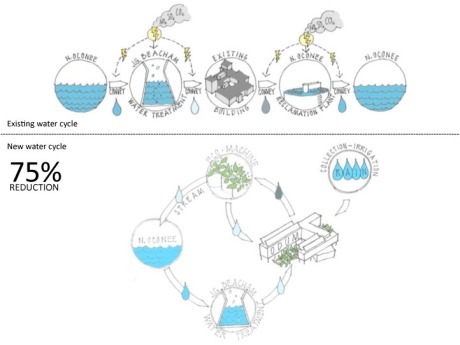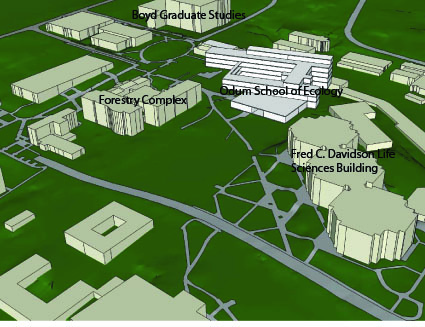Odum Green Building Concept Design Revealed
January 24, 2009
Wednesday, January 21 2009 was a truly great day for the Odum School of Ecology. The Architectural Firm BNIM and the Green Building Planning Committee finally revealed the Concept Design Plan.
Our Vision:
Our understanding of emerging global economic and environmental issues leads us to forge a sustainable building ethic for the world’s first college-level ecology program– the Odum School of Ecology. Our goal is a building that is ecologically resilient, socially just and economically sound.
Envision a world where the earth’s complex living systems are intricately linked and in delicate, harmonious balance with their surroundings. Serving as a model for how natural and built environments will collaborate in the future, the Odum School of Ecology will transform education and research and set an example for a future sustainable society.

An artistic rendering of the Odum School of Ecology Green Building in situ. Complete with green walls, green roofs, streams, a courtyard, a green house, photovoltaic cells, and most importantly the ability to influence building design on campus indefinitely.

'Building Habitat' The Odum School of Ecology Green Building is pictured in context with the rest of the surrounding buildings, to give the viewer a perspective of size, spatial orientation, and an idea of what the 'neighborhood' will be like upon construction.
The conceptual design of the Odum Green Building proceeded with a number of goals or visions in mind. These elements include PEDAGOGY, BIODIVERSITY, LIVABILITY, ENERGY, WATER, and NUTRIENT CYCLING. Each of these visions are embodied in the design of what will be the World’s most Sustainable Teaching and Research Laboratory.
PEDAGOGY
To create change, the building and site will serve as a multidisciplinary and interdisciplinary transparent living laboratory available to everyone.
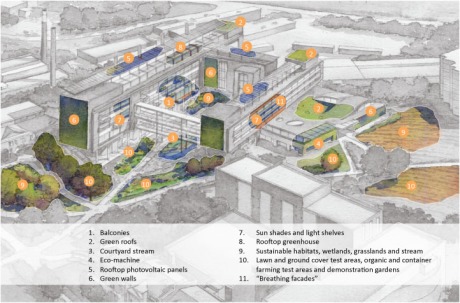
Indoor greenhouses and terrariums with regional and tropical habitats, aquariums, compelling soil lab walls for hydrologic processes, indoor eco-machines for wetland ecologies, in a processional that dramatically enriches the building experience. Interactive computational study centers are distributed throughout to immerse students in G.I.S. based geo-tracking and geo-informatics. Annual updates and the links between eco-systems and climate, population, infectious diseases, crops and crop systems, plant reproduction, etc will be made publicly accessible through Odum's posters and screen saver series and publicly displayed. Rainwater collected from the roof and purified water from the eco-machine feed the stream and is used for on-site irrigation. A regional/seasonal scale cafe is located in the main public space.
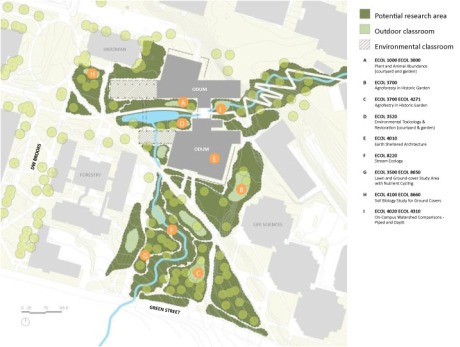
The existing site area, west to DW Brooks and south to Green St, will be transformed into a series of natural working systems that support Ecology, Forestry and other UGA curricula. New outdoor educational settings – Sustainable habitats, wetlands, grasslands, and streams – will demonstrate the power of landscape to restore plant and animal diversity, stream ecologies, watersheds and soils.
BIODIVERSITY
Embracing ecological diversity, complexity and resilience, the project will allow natural systems to self organize, heal and regenerate ecological processes. This, in turn, will provide food, fiber and shelter for living species including humans.
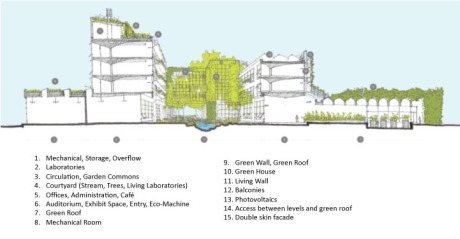
The enriched experience provides extensive green roofs planted in conjunction with lab curriculum to attract desired species; integrated green walls for shading and habitat; and rainwater capture and reuse to develop wetlands, grasslands, and streams.

An overview of the biodiversity zones going west to DW Brooks and south to Green St. The sensitivity and diversity of developing the site this way offers a more appropriate headwaters condition, increases habitat potential, offers curriculum opportunities and provides readily accessible public demonstration areas.
LIVABILITY
By encouraging interaction and collaboration amount the university, all sectors of the environmental community, and the general public, and by incorporating the healthiest building practices, this project will create inspiring and healthy indoor and outdoor spaces where people ling to work, study and visit.

The site of the Odum School of Ecology is at the intersection of two main pedestrian thoroughfares of the University of Georgia Campus. Our vision for this gateway connection is to increase the outreach of our and our neighboring schools’ work via the experience of just walking by. Cultural amenities unique to the function of the School of Ecology are readily accessible within the interior courtyard

BUILDING SPECIES The Odum School Facility will have six fundamental space typologies or species each having unique functional and comfort needs
ENERGY
The building will operate on a carbon neutral basis that demonstrates appropriate demand and supply technologies at various scales.

The building is designed to face solar south, providing the best access to both passive and active strategies available daily from sunlight. 100% of all interior spaces will be naturally daylit. Access to daylight has been shown to increase productivity and accuracy of building users. Use of photovoltaics (solar panels) will be the primary energy source for the school. Solar panels will be located on the roof, on grade and integrated into the building facade and shading devices.

Every time the building or a portion of the building operates in natural ventilation mode the Odum School's impact on the environment is reduced. The office wing uses a double skin facade on the south side and accepts fresh air from the summer dominant NNW wind. Lab research spaces receive air from operable windows on the south side and exhaust air through the filtered mechanical system.

The office wing uses an underfloor air system, delivering the air where it is needed most. This system lowers air delivery temperature, reducing the energy required for cooling while providing individual control over the airflow and direction. Lab areas use an efficient overhead supply system with a heat exchange recovery wheel on the return side to capture reusable heat as the conditioned air leaves the exhaust stack.
WATER
Occupying a headwater to the Oconee River watershed, the project will celebrate water by conserving and regenerating freshwater cycles, directly linking the building sire to the river.
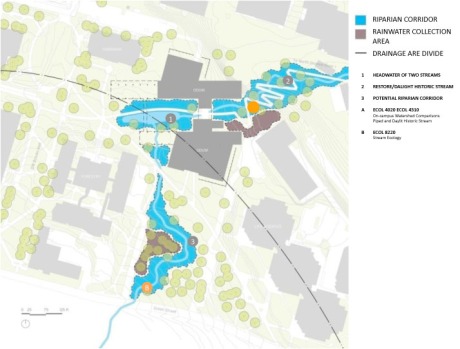
The project site area straddles a ridge that divides two drainage areas which are both part of the Oconee watershed. Current site design rapidly puts all storm water into pipes sending it away. Environmentally regenerative and restorative techniques at the new site development will create attractive, usable and educational habitat zones along the exposed waterways.
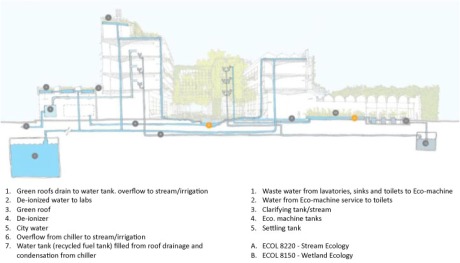
The building will manifest the highest level of water conservation possible for building type and location. In addition to capturing rainwater, it will recapture grey water and black water through the eco-machine, ensuring the lowest water use with the highest ecological richness.
NUTRIENT CYCLING
Mimicking nature, the building will operate waste-free by integrating natural systems and adopting and inventing sustainable operating practices that harvest nutrients.
A great deal of time, energy, and thought went into the conceptualization, modeling, sketches, and ideas presented on Wednesday. However, the hardest part is just beginning, and we need your help. Any comments, questions, suggestions, ideas, or criticisms that you may have are extremely important to us and we want; no, we need to hear from you. Each and every comment or concern will be brought to the Committee’s attention, and will be addressed.
Building Conceptualization
January 14, 2009
The Odum School of Ecology’s Green Building Planning Committee has been hard at work revising sketches, finalizing ideas, and proceeding down the path of building conceptualization toward a complete design. The images and descriptions that follow are excerpts taken from the 75% completion design teleconference.

Species space relationships are shown in a compressed building format, illustrating the integrated approach to learning the Odum School will employ.

A horizontal space relationship can be seen while still keeping in mind the types of vertical spatial orientations which are proposed.

This glass separated cubicle meeting space design conveys the flexibility and open style in which the Odum School has been designed.
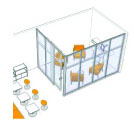
This combination study bar area and glass meeting office are spaces where students could study, meet and talk with professors.

An open lounge area allows students and professors a place to relax as well as openly and freely interact.

A student lounge of this design would provide student organizations a meeting space to casually discuss and plan upcoming events.
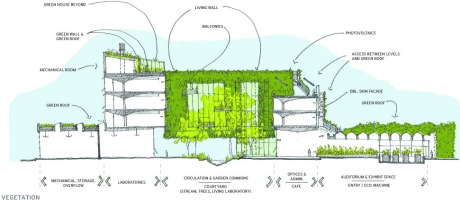
The Odum Building will be a facility constructed for education and research, as well as to be studied and researched. Built into the design is the idea of the 'living wall' or 'green scrim' where plants are the major decorating scheme on the exterior. These plants will serve many purposes including keeping the building's interior shaded and cool, essentially transforming the building into its own plant identification course, and by providing a natural habitat for local creatures, it will further blend the line between building and nature.
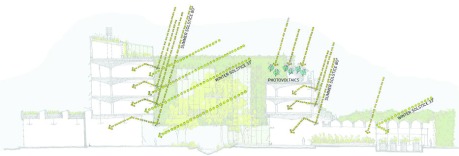
The Odum Building is designed to make maximum usage of natural lighting while minimizing thermal heating. Part of the energy production scheme is to install solar panels on the roof and side of the building to collect the sun's energy and satisfy at least a portion of the building's power needs.

Building construction illustrating use of natural ventilation for air circulation. Making use of the natural properties of air, the building can be naturally cooled in the summer by opening windows, allowing the hot air to escape and cooler air to be drawn in from the bottom floors.

Planned purification, recycling, and reuse of water in the Odum School can be seen from this architectural sketch.
The charettes, design meetings, planning, and conceptualizing are all finished. The final Odum School of Ecology Conceptual Plan will be presented by the architectural firm BNIM on Wednesday January 21, 2009 at 3:00 PM in the Ecology Building’s Auditorium. Anyone interested in the final book, or the design process is urged to attend.
As always, if you have any questions or comments, feel free to email me at jlmck10@uga.edu and I will try to get back to you as soon as possible. Hopefully, I will see all of you on January 21 at 3:00PM in the Ecology Auditorium.

